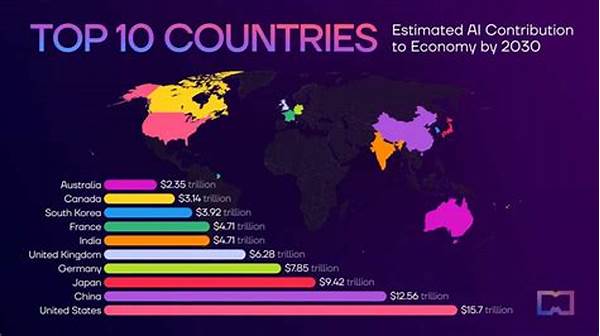Certainly! Crafting an article with the specified requirements involves blending various writing styles, from storytelling to promotional content, in a comprehensive narrative. Here’s how it might look:
Read More : How Ai Influences Government Policies
—
In an era where technology reshapes our daily lives, Artificial Intelligence (AI) emerges as a colossal force, wielding the potential to redefine economies and societies, particularly in developing countries. This powerful tool, no longer confined to the realms of tech giants and advanced economies, is making its way into regions that crave transformation. Just imagine a world where AI supports developing countries by revolutionizing sectors like agriculture, healthcare, and education. It’s both a captivating vision and a pulsating reality on the horizon.
Consider Sarah, a farmer in a rural village in Kenya. Traditionally reliant on seasonal forecasts that are vague at best, Sarah now taps into AI-driven solutions that predict weather patterns with uncanny precision. These insights inform her planting techniques, reducing risk and boosting her crop yields. This is just one example of how AI supports developing countries by offering tailored solutions to age-old challenges.
But why stop at farming when the possibilities are limitless? Picture a clinic in Bangladesh where AI-driven diagnostic tools assist doctors in pinpointing diseases earlier than ever before. Or visualize AI-powered educational platforms closing the literacy gap in remote regions of South America. In these narratives, AI isn’t just supporting developing countries; it’s empowering them to leapfrog into a future they only dared to dream of.
Yet, amidst the enthusiasm, challenges persist. From infrastructure limitations to concerns about job displacement, the journey toward seamless AI integration is rife with obstacles. However, it is precisely these challenges that drive relentless innovations and adaptations, each striving to prove how AI supports developing countries can be both sustainable and inclusive.
The Potential and Pitfalls of AI in Developing Regions
As AI technology continues to weave its way through the fabric of developing nations, its impact manifests in myriad ways. It’s not just about leapfrogging technology gaps but about reshaping the socioeconomic landscape of entire nations. How AI supports developing countries is seen in initiatives like AI-enabled financial services, which allow entrepreneurs in sub-Saharan Africa to access micro-loans with unprecedented ease.
Despite its impressive applications, AI’s integration is not without hurdles. Concerns about data privacy, ethical implications, and the digital divide must be addressed. Imagine for a moment a scenario where AI, while intending to uplift, instead exacerbates inequalities due to uneven access to technology. This dual nature of progress versus potential setback makes the roadmap toward AI-enabled growth both exciting and complex.
Moreover, developing nations must invest in building their tech ecosystems to fully harness AI’s benefits. This includes fostering digital literacy among the population and creating infrastructures that support AI deployment at scale. As these regions continue to embrace AI, success stories become invaluable testaments to how AI supports developing countries across the globe.
Success Stories and Real-Life Transformations
One exemplary tale comes from India, where AI has revolutionized healthcare diagnostics in rural clinics with limited access to medical professionals. By harnessing machine learning, doctors are now informed with accurate disease predictions, enabling timely interventions. In another real-life narrative, AI algorithms assist wildlife conservationists by predicting animal migrations and poaching hotspots, emphasizing environmental stewardship as an extension of how AI supports developing countries.
The question remains: How can developing countries amplify their adoption of AI while mitigating associated risks? Partnerships between governments, private sectors, and international organizations are crucial. Collaborative efforts will ensure that AI’s deployment is contextually relevant and sustainably integrated.
—
Key Aspects of How AI Supports Developing Countries
The Future of AI in Emerging Markets
As we embark on this technological voyage, AI’s potential to transform developing countries is not just a possibility; it is an evolving reality. Did you know that, according to recent research, AI-driven improvements could boost global GDP by 1.2% over the next decade? It’s a statistic that highlights the profound impact AI can have, particularly in places striving to find their footing in the competitive global landscape.
In this discussion, we delve into not just the potential benefits but also the ethical considerations of how AI supports developing countries. It’s crucial to strike a balance between leveraging AI’s capabilities and ensuring equitable growth. Imagine international panels, think tanks, and summits focused solely on the responsible deployment of AI in developing regions—a collective effort to ensure that no country gets left behind.
Challenges and Opportunities
In conclusion, AI represents a spectrum of opportunities, but with every innovation comes responsibility. Encouragingly, the global narrative is shifting towards responsible AI development, focusing on sustainability and inclusivity. Developing countries stand at the brink of unprecedented growth, armed with AI strategies that promise to propel them into the 21st century.
From collaborative international frameworks to localized initiatives, the path forward is clear: AI is here to stay, and its role in supporting developing nations will only grow. As we continue exploring this fascinating intersection of technology and development, the stories we tell today will shape the legacies of tomorrow, forging new pathways in a digitally-driven world.


